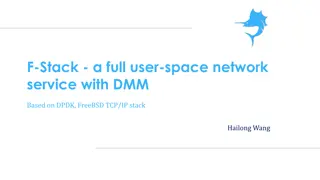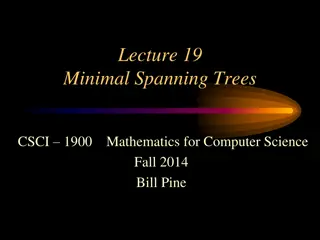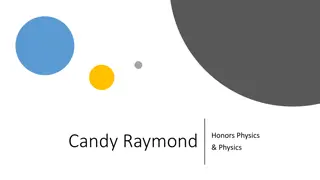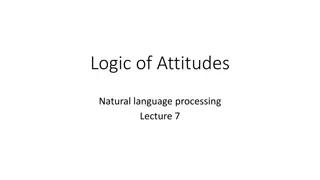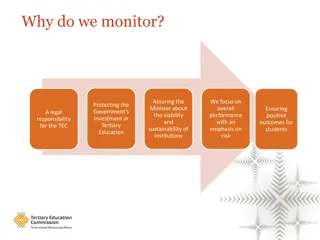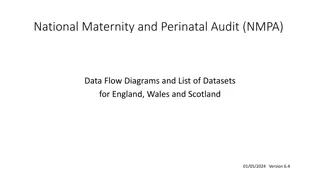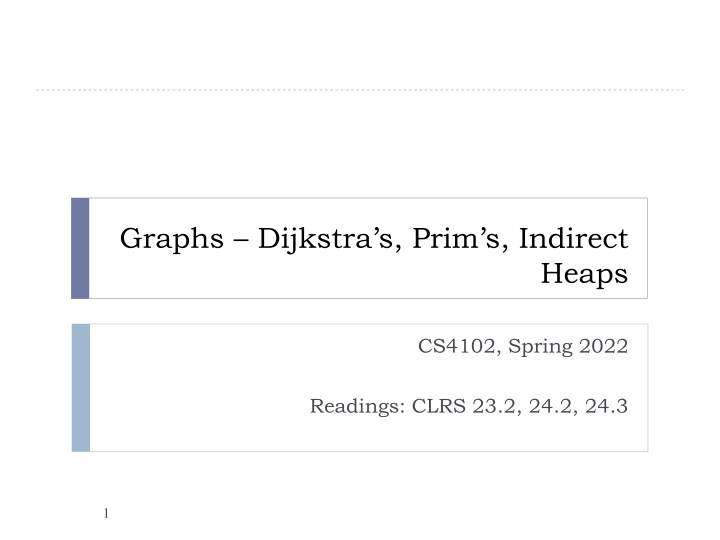
Efficient Graph Algorithms: Dijkstra's and Prim's with Indirect Heaps
Discover the similarities between Dijkstra's and Prim's algorithms, enhanced by the use of Indirect Heaps for efficiency. Learn about weighted shortest paths, the principles behind Dijkstra's algorithm, and how it works step by step. Dive into the naive analysis of finding unknown distances and the implementation of Dijkstra's algorithm in a graph. Explore the time complexity implications and practical considerations for optimizing these algorithms in graph-related applications.
Download Presentation

Please find below an Image/Link to download the presentation.
The content on the website is provided AS IS for your information and personal use only. It may not be sold, licensed, or shared on other websites without obtaining consent from the author. If you encounter any issues during the download, it is possible that the publisher has removed the file from their server.
You are allowed to download the files provided on this website for personal or commercial use, subject to the condition that they are used lawfully. All files are the property of their respective owners.
The content on the website is provided AS IS for your information and personal use only. It may not be sold, licensed, or shared on other websites without obtaining consent from the author.
E N D
Presentation Transcript
Graphs Dijkstras, Prims, Indirect Heaps CS4102, Spring 2022 Readings: CLRS 23.2, 24.2, 24.3 1
Topics Dijkstra s algorithm + na ve runtime Review!! Prim s algorithm + na ve runtime Also Review!!! Why these two algorithms? Turns out they are VERY similar Indirect Heaps A new data structure that makes both algorithms above more efficient 2
Weighted Shortest Path no negative weight edges. Dijkstra s algorithm: uses similar ideas as the unweighted case. Greedy algorithms: do what seems to be best at every decision point. v S s V -S known unknown 4
Dijkstras algorithm Initialize each vertex s distance as infinity Start at a given vertex s Update s s distance to be 0 Repeat Pick the next unknown vertex with the shortest distance to be the next v If no more vertices are unknown, terminate loop Mark v as known For each edge from v to adjacent unknown vertices w If the total distance to w is less than the current distance to w Update w s distance and the path to w 5
v1 v0 2 5 1 1 2 1 1 v2 v3 v4 6 5 3 2 V Known Dist path 10 v5 v0 v6 v1 v2 v3 v4 v5 v6
void Graph::dijkstra(Vertex s){ Vertex v,w; s.dist = 0; while (there exist unknown vertices, find the unknown v with the smallest distance) v.known = true; for each w adjacent to v if (!w.known) if (v.dist + Cost_VW < w.dist){ w.dist = v.dist + Cost_VW; w.path = v; } } } 7
Nave Analysis How long does it take to find the smallest unknown distance? simple scan using an array: O(V) Total running time: Using a simple scan: O(V2+E) = O(V2) 8
Dijkstra' Algorithm dijkstra(G, wt, s) init PQ to be empty; PQ.Insert(s, dist=0); parent[s] = NULL; dist[s] = 0; while (PQ not empty) v = PQ.ExtractMin(); for each w adj to v if (w is unseen) { dist[w] = dist[v] + wt(v,w) PQ.Insert(w, dist[w] ); parent[w] = v; } else if (w is fringe && dist[v] + wt(v,w) < dist[w] ) { dist[w] = dist[v] + wt(v,w) PQ.decreaseKey(w, dist[w]); parent[w] = v; } 9
Analysis of Priority Queue implementation? How long does it take to find the smallest unknown distance? extract min from PQ: O(log(V)) But called V times total, so O(V*log(V)) Inner loop: runs E times like before but . Each edge could force a PQ.decreaseKey() call, runtime?? Na ve decreaseKey() is linear time: O(V), total of O(E*V) So, total is O(V*log(V) + E*V). Is this better?? Earlier, using a simple scan: O(V2+E) = O(V2) 10
Prims algorithm Idea: Grow a tree by adding an edge from the known vertices to the unknown vertices. Pick the edge with the smallest weight. G v known 12
Prims Algorithm for MST Pick one node as the root, Incrementally add edges that connect a new vertex to the tree. Pick the edge (u,v) where: u is in the tree, v is not AND where the edge weight is the smallest of all edges (where u is in the tree and v is not). 13
MST 2 v2 v1 3 1 10 4 2 7 v3 v4 v5 8 5 4 6 1 v6 v7 14
v1 {v1, v4} {v1, v2} {v4, v3} {v4, v7} {v7, v6} {v7, v5} MST 2 v2 v1 3 1 10 4 2 7 v3 v4 v5 8 5 4 6 v2 v1 1 v6 v7 v5 v3 v4 v7 v6 15
Prims MST Algorithm Greedy strategy: Choose some start vertex as current-tree Greedy rule: Add edge from graph to current-tree that has the lowest weight of edges that have one vertex in the tree and one not in the tree. Thus builds-up one tree by adding a new edge to it Can this lead to an infeasible solution? (Tell me why not.) Is it optimal? (Yes. Need a proof.) 16
Tracking Edges for Prims MST Candidate edges: edge from a tree-node to a non- tree node Since we ll choose smallest, keep only one candidate edge for each non-tree node But, may need to make sure we always have the smallest edge for each non-tree node Fringe-nodes: non-trees nodes adjacent to the tree Need data structure to hold fringe-nodes Priority queue, ordered by min-edge weight May need to update priorities! 17
Prims Algorithm MST-Prim(G, wt) init PQ to be empty; PQ.Insert(s, wt=0); parent[s] = NULL; while (PQ not empty) v = PQ.ExtractMin(); for each w adj to v if (w is unseen) { PQ.Insert(w, wt(v,w)); parent[w] = v; } else if (w is fringe && wt[v,w] < fringeWt(w)){ PQ.decreaseKey(w, wt[v,w]); parent[w] = v; } 18
Cost of Prims Algorithm Looks VERY similar to Dijkstra sdoesn t it!! Outer loop extracts from PQ total of V times O(V*log(V)) Inner loop runs E times total, but calls decreaseKey() If decreaseKey() is na ve and linear (V), then O(E*V) Total: O(V*log(V) + E*V) 19
Compare Both Dijkstra and Prim have same structure, and suffer from a na ve, slow implementation of decreaseKey() Let s compare the code real fast, and then introduce the Indirect Heap 21
Dijkstra' Algorithm dijkstra(G, wt, s) init PQ to be empty; PQ.Insert(s, dist=0); parent[s] = NULL; dist[s] = 0; while (PQ not empty) v = PQ.ExtractMin(); for each w adj to v if (w is unseen) { dist[w] = dist[v] + wt(v,w) PQ.Insert(w, dist[w] ); parent[w] = v; } else if (w is fringe && dist[v] + wt(v,w) < dist[w] ) { dist[w] = dist[v] + wt(v,w) PQ.decreaseKey(w, dist[w]); parent[w] = v; } 22
Prims Algorithm MST-Prim(G, wt) init PQ to be empty; PQ.Insert(s, wt=0); parent[s] = NULL; while (PQ not empty) v = PQ.ExtractMin(); for each w adj to v if (w is unseen) { PQ.Insert(w, wt(v,w)); parent[w] = v; } else if (w is fringe && wt[v,w] < fringeWt(w)){ PQ.decreaseKey(w, wt[v,w]); parent[w] = v; } 23
Better PQ Implementations Goal: Lower cost of PQ.decreaseKey() Example of na ve approach first 24
Better PQ Implementations Goal: Lower cost of PQ.decreaseKey() Indirect Heap 25
Better PQ Implementations (2) Cost of Dijkstra s and Prim s O(V*log(V) + E*V) Indirect heap makes bolded V become log(V) New Cost: O(V*log(V) + E*log(V)) = O(E*log(V)) 26
Proving Dijkstras Correct Using Proof by Induction 27
Structure of an induction proof for correctness Base case Show the algorithm correct for some small input size Inductive Hypothesis Assume algorithm is correct for all input sizes up to some size E.g. for input sizes up to not including k Or equivalently, up to and including n. It doesn t matter how you name the boundary as long as you re consistent in next step! Inductive Step Show algorithm is correct for next larger input size E.g. for size k Or, for n+1 if you used n to define Inductive Hypothesis 28
Dijkstra' Algorithm dijkstra(G, wt, s) init PQ to be empty; PQ.Insert(s, dist=0); parent[s] = NULL; dist[s] = 0; while (PQ not empty) v = PQ.ExtractMin(); for each w adj to v if (w is unseen) { dist[w] = dist[v] + wt(v,w) PQ.Insert(w, dist[w] ); parent[w] = v; } else if (w is fringe && dist[v] + wt(v,w) < dist[w] ) { dist[w] = dist[v] + wt(v,w) PQ.decreaseKey(w, dist[w]); parent[w] = v; } 29
Summary 32
What Did We Learn? Review of Dijkstra s and Prim s Almost same algorithm but solve different problems!! Review of Na ve runtime analysis Indirect heap and better runtime for each algorithm Use of induction to prove Dijkstra s find minimum distance to every vertex 33







